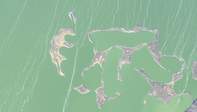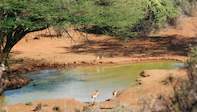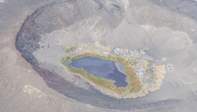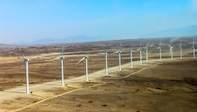
Lake Turkana also known as the Jade Sea, was originally named Lake Rudolph in 1888 and was renamed Lake Turkana in 1975. Lake Turkana is famous for it's greenish-blue colours, hence the nickname the Jade Sea. It is the largest alkaline lake in the world.
Lake Turkana is 300 Km long and 50 Km wide, which also makes it the largest lake in Kenya (although, Lake Victoria which is shared with Kenya, Tanzania and Uganda is larger). It is also the world's largest permanent desert lake. The water is potable, but not very palatable.
Three rivers feed into the lake but there is no out flow, all water loss is via evaporation.
Lake Turkana National Parks

Lake Turkana National Parks comprise of Sibiloi National Park, the South Island and Central Island National Parks covering an area located within the Lake Turkana basin, whose total surface area is 7 million hectare. These national parks have collectively been designated as a UNESCO World Heritage Site.
The lake is surrounded by an arid, seemingly extraterrestrial empty landscape devoid of life. There are numerous volcanic overflows with petrified forests. The island parks are breeding habitats for Nile crocodiles, hippopotamus and several snake species.
It is believed that the lake was much larger than it is today, supporting a richer and more varied flora and fauna. Yet, today there are around 400 species of birds and some 200 - 300 Kg nile perch, making it a fantastic place for sport fishing and birding.
Archaeological Significance of Lake Turkana

An abundance of fossils have been found in the area around Lake Turkana. Sibiloi National Park is known as “the cradle of mankind” as it is home to important archaeological sites such as Koobi Fora where fossils have lead to a greater understanding of human evolution than any other site on the continent.
Most recently archaeologists claim that they have unearthed the earliest evidence of warfare between hunter-gatherers to be scientifically dated, at a remote site in northern Kenya. The 10,000-year-old remains of 27 people found west of Lake Turkana show that they met violent deaths.
Many experts have argued that conflict only came about as humans became more settled. These people, by contrast, were apparently nomadic hunter-gatherers.
Climate
At an altitude of only 300 m above sea level, Lake Turkana is one of the hottest places in Kenya, with temperatures of 50 C not being uncommon. Onshore and offshore winds can be very strong, as the lake warms and cools more slowly than the land. Sudden violent storms are frequent.Lake Turkana Wind Power Project

Lake Turkana has notorious strong desert winds which can make sailing on the lake a hazardous affair. This persistent wind is now being utilised by the single largest investment in Kenya’s history the Lake Turkana Wind Power Project.
This investment has built a wind farm that covers 40,000 acres (162 km²) and is located in Loiyangalani District, Marsabit County. The aim of the farm is to provide low cost wind power to the national grid. On completion in 2018, the project will comprise of 365 wind turbines. At the moment the project is bringing jobs and improved infrastructure to this very remote northern part of Kenya.

 Sibiloi National Park in Kenya stands on the edge of the largest desert lake in the world, Lake Turkana. The park is a World Heritage Site a...
Sibiloi National Park in Kenya stands on the edge of the largest desert lake in the world, Lake Turkana. The park is a World Heritage Site a... Kenya safari lodges in the Rift Valley region of Kenya are located along a chain of lakes, Turkana, Nakuru, Naivasha, Elmenteita and Baringo...
Kenya safari lodges in the Rift Valley region of Kenya are located along a chain of lakes, Turkana, Nakuru, Naivasha, Elmenteita and Baringo...